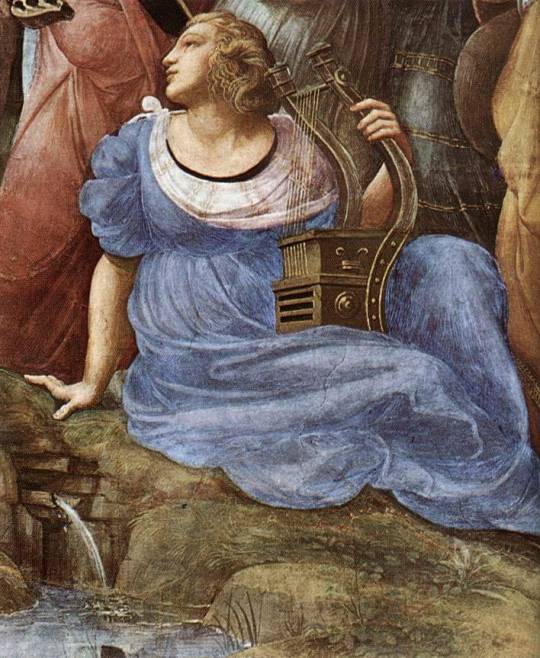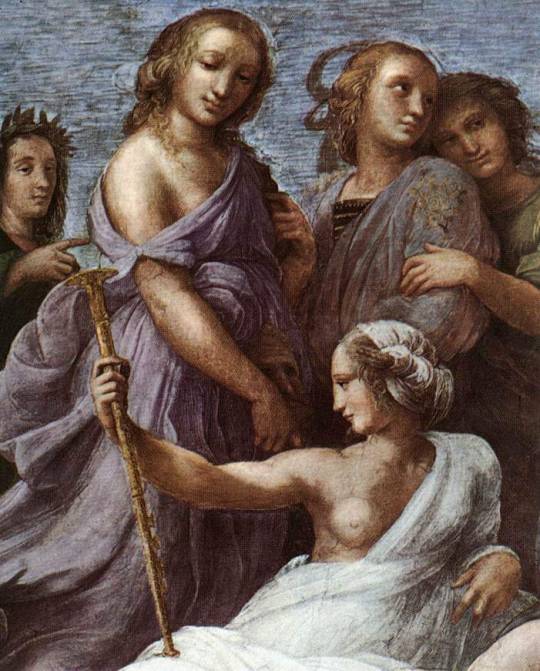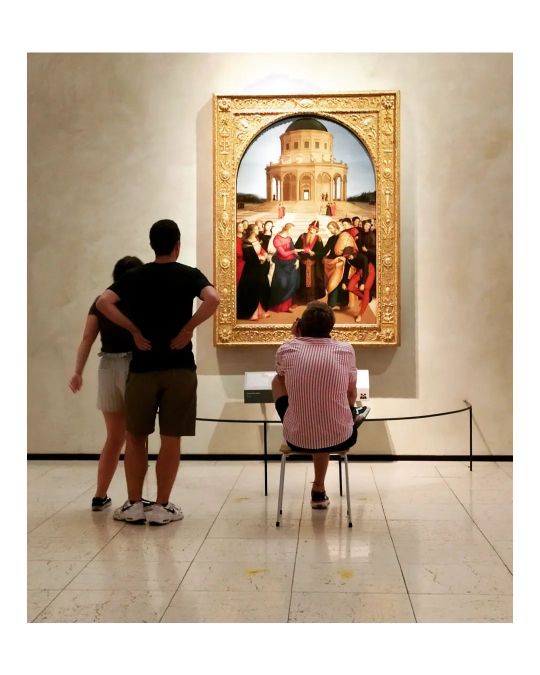#muse| raffaello
Explore tagged Tumblr posts
Note
ღ ( & one more for now! Dark LeoRaph uwu )
| Inbox me a ‘ღ’ and I’ll rate you with the following

"Pft what? Mister gloom an' doom? sure 'll rate 'em. Rate 'em as the whinin' whimp he can bee ha!"
Romantic attraction: none | very low | low | medium | high | very high | extreme
"Fine maybe jus' maybe I ain't got a dislike for 'em giving 'em a hard time though? It's fun watching him get all upset an' pissed. Always acttin' like he's better? But well I also got a issue not leaving 'em alone when he tries to be. I ain't sort or nothin' can' be not here. But well wanna make sure hes fine when hurt. Sides if hes looking for revenge? I wanna tag along clearly."
Sexual attraction: none | very low | low | medium |high| very high | extreme
"What? I know when I see a looker when I see one and he's got a look that works on me. Love when he scowls a lot. Like a lot lot. Tall and muscular? Especially those back muscles? I wanna see how they look with him face down, and bent over."
Aesthetic attraction: none | very low | low| medium | high | very high | extreme
"Eh I dunno what 'hat means? Like his looks if that what it means? Why not fuckin' say 'hat fuckin' out here with stupid fancy words when smaller words exist." He huffs a bit then think about it soon after. "Yeah he look's nice I 'ike the color of his scales that blue color nice. Make's pears look hot with how top heavy his build is, or I guess in the opposite direction? eh he's hot."
Sensual attraction: none | very low | low | medium |high | very high | extreme
"I mean I already admitted to the sexual kind hadn' I?" Slightly scratching at his head with the tip of a claw as his brow knots up in thought.
He's a dummy uwu a special kind of dummy, but yes as you can see Raffa got some many thoughts when it comes to their own fearless leader. He may not fully understand his own emotions when not something physical but lets just say Dark Leo got a grip on Raffa that even Raffa doesn't fully understand the binds his loyalty to them. He may seem willing to stab them in the back and go against him? But in truth? He'll always go back. Its a near possessive obsession on his own end. Where Raph gets a kick out of railing up his own brother. Raffa just craves testing and pushing Drak Leo's own stance. Take a lot of Raph own ways just twist it into Raffa view in that Dark Leo basically is his so he can be and do as he wants with and to them uwu. He still loves them clearly it's just shown in this way because he will display a faint fondness he holds for them when they are alone of course. Because he gotta challenge them when their brothers are around still.
#muse| raffaello#stasandsavages#[ chains that bind me of my own doing ♥︎ starsandsavages]#send ღ to rate your muse#meme answers#ic reply#((changed up how i am answering these uwu))
4 notes
·
View notes
Text

La velata, Raffaello Sanzio, about 1516
#art history#art#italian art#aesthethic#painting#16th century#velata#portrait#fashion history#raffaello sanzio#raphael#fornarina#muse#veil#rinascimento#palazzo pitti#uffizi#golden
54 notes
·
View notes
Text


Raffaello Sorbi (Italian, 1844-1931) Fidia che scolpisce la statua di Minerva per il Partenone, Detail, 1869
#Raffaello Sorbi#italian#1800s#Fidia che scolpisce la statua di Minerva#Fidia che scolpisce la statua di Minerva per il Partenone#Lo studio di Fidia#Phidias’s workshop or Phidias carving the Statue of Minerva for the Parthenon#art#southern europe#classical art#mediterranean#fine art#european art#europe#european#oil painting#fine arts#europa#italy#muse#beautiful woman#beauty#western civilization#italian art
46 notes
·
View notes
Text


The Parnassus (Apollo with the nine muses)
Rafael Sanzio, 1509-1511
#history art#classic art#obras de arte#raffaello sanzio#high renaissance#nine muses#artes visuais#study art#mithology
0 notes
Note
Back on your "angelic complexion" musings.
Considering the archangel Raphael is associated with healing... He's 100% LARPing that "saviour" persona. If you consider Earth canon to DnD, he might as well also be LARPing Raffaello Sanzio for the full "painter, poet, great master, beautiful as hell" combo
(This ask refers to the theory that Raphael has chosen his own name himself and he’s chosen a name associated with angels on purpose)
Yeeeees! Exactly!!! It would be so in character for him, that’s for sure.
(Thank you for the ask <3)
33 notes
·
View notes
Text

👑₊ ⁺ ❪ # 𝙋𝘼𝙍𝘿𝙄𝙎𝙀𝙇𝙊𝙎𝙏 ❫ ━━ a 20+ , multifandom multi - muse roleplay blog ( extremely private selective && mutual only , sporadic activity ) for various canon divergent && head canon - based portyals ft. Cait Sith from Final Fantasy VII . this blog will include the following fandoms ; granblue fanatasy , final fantasy vii , final fantasy xiv , fear & hunger termina , the amazing digital circus , limbus company && more .
₊ ⁺ Other Important Links: carrd , interest tracker , permanent starter call , inbox call , prompts tag , mains && affiliates call , promo , credits .
👑₊ ⁺ ❪ 𝘼 𝙎𝙏𝙐𝘿𝙔 𝙄𝙉 . . . ❫ ━━ lying to protect those you love , robots can have thoughts too , love hurts , mourning loved ones , religions , once misunderstood is now accepted , depression , revenge && letting go of that revenge , exploring what more the outside world will give you , guilt && longing , self - hatred , love is something that is painful but comforting .
₊ ⁺ Affiliates: obedientmade , r-adio , l-ucitiel , jizzlords
👑₊ ⁺ ❪ 𝙀𝙈𝘽𝙍𝘼𝘾𝙀𝘿 𝘽𝙔 𝙈𝘼𝙍𝙄𝘽𝙀𝙇𝙇𝙀 . 27 . 𝙎𝙃𝙀/𝙏𝙃𝙀𝙔 . ❫
𝙈𝙐𝙎𝙀 𝙇𝙄𝙎𝙏: plain = primary , green = secondary , blue = tertiary , orange = requested .
𝙂𝙍𝘼𝙉𝘽𝙇𝙐𝙀 𝙁𝘼𝙉𝙏𝘼𝙎𝙔: Sandalphon , Belial , Cassius , Arthur , Galleon .
𝙁𝙄𝙉𝘼𝙇 𝙁𝘼𝙉𝙏𝘼𝙎𝙔 𝙑𝙄𝙄: Cait Sith , Red XIII , Marlene .
𝙁𝙄𝙉𝘼𝙇 𝙁𝘼𝙉𝙏𝘼𝙎𝙔 𝙓𝙄𝙑: Alphinaud Leveilleur , Alisaie Leveilleur , Fandaniel , G'raha Tia .
𝙊𝙆𝘼𝙂𝙀: 𝙎𝙃𝘼𝘿𝙊𝙒 𝙆𝙄𝙉𝙂: Epros .
𝙁𝙄𝙉𝘼𝙇 𝙁𝘼𝙉𝙏𝘼𝙎𝙔 𝙁𝘼𝘽𝙇𝙀𝙎: 𝘾𝙃𝙊𝘾𝙊𝘽𝙊'𝙎 𝘿𝙐𝙉𝙂𝙀𝙊𝙉: Raffaello , Chocobo , Shirma .
𝙁𝙀𝘼𝙍 & 𝙃𝙐𝙉𝙂𝙀𝙍 𝙏𝙀𝙍𝙈𝙄𝙉𝘼: Daan Von Dutch , Marina , Levi , Pocketcat , Abella .
𝙏𝙃𝙀 𝘼𝙈𝘼𝙕𝙄𝙉𝙂 𝘿𝙄𝙂𝙄𝙏𝘼𝙇 𝘾𝙄𝙍𝘾𝙐𝙎: Jax , Moon .
𝙏𝙃𝙀 𝘿𝙐𝙈𝙈𝙔'𝙎 𝘿𝙐𝙈𝙈𝙔: Paris the Puppet , Yumi Wright , Polakov .
𝙉𝙄𝙀𝙍 / 𝙉𝙄𝙀𝙍 𝘼𝙐𝙏𝙊𝙈𝘼𝙏𝘼: 2B , Emil , 9S .
𝙇𝙊𝘽𝙊𝙏𝙊𝙈𝙔 𝘾𝙊𝙍𝙋𝙊𝙍𝘼𝙏𝙄𝙊𝙉 / 𝙇𝙄𝙈𝘽𝙐𝙎 𝘾𝙊𝙈𝙋𝘼𝙉𝙔: Yesod , Yi Sang
𝙃𝘼𝙕𝘽𝙄𝙉 𝙃𝙊𝙏𝙀𝙇 : Rosie .
𝙊𝘾: Bionda Orrore .
2 notes
·
View notes
Note
What are rare-pairs that you’re passionate about? Is there anything you would have changed when you started writing now that you have more experience? Do you have developed dynamics with the OC of another mun that has influenced your OC or Canon muse?
What are rare-pairs that you’re passionate about?
what aren't rarepairs i'm passionate about?
in all seriousness, i have quite a few. luckmelvi is obviously a big one for me, but you knew that already; i wasn't expecting them to have the chemistry they did at the start, and while they took me by surprise i don't regret making the suggestion at all. they're honestly one of my favorite ships i've ever written so they get the honor of having a full paragraph.
shiroe/souji and shiroe/krusty of log horizon fame are also up there. raffaello/kanami/leonardo is also up there (i mean, seriously, raffaello is ALMOST the name of a teenage mutant ninja turtle and leonardo is a tmnt superfan, he was meant to join the relationship). same with kanami/leonardo separately and kanami/elias. and then of course there's louis/mycroft, baren/sakichi, roland/vanitas, cahir/regis, shang qinghua/liu qingge, eomer/faramir ... um, anyway the list is actually endless and that's only speaking of my canons. i'm inherently into rarepairs by virtue of them being rarepairs.
Is there anything you would have changed when you started writing now that you have more experience?
i guess there's a lot of things i would have changed. i started without any knowledge of rpc culture and stuff so i was kind of a pushover, i would have told myself back then to have a little bit more of a spine about things that don't really matter. i also would have probably stayed clear of a lot of drama. i really don't mean to cause it, but sometimes i give my opinion where it's not asked for or necessary and it took me a long time to figure out that there are lines you shouldn't cross and stuff.
in terms of my writing, i wouldn't really change anything. i was pretty bad when i started out but nobody just starts out good, and i was 14 anyway.
Do you have developed dynamics with the OC of another mun that has influenced your OC or Canon muse?
i actually don't write with ocs overly much so... nooooot currently?
well, that's not ENTIRELY true. actually it was a lot more common in the past. i remember i wrote a character that was so far back in the lore of his source that he was basically an oc, kunwu; because i started plotting between him and my friend's touzannou (a character in a similar situation) he actually took a step onto a plot i didn't expect at first and i was pretty happy about that.
also, playing dnd with you guys influences my dnd-based ocs all the time! yemevon's ideal character progression was just going to be acceptance and contentment until i started seeing more of other characters. i started thinking things like "what if dharlan's energy rubbed off on them over time?" or "what if their eventual friendship with yu makes them break their own rules surrounding death?".
oh, and in regards to dnd oc's i'd be remiss not to mention tempest. he was a completely different character before vel entered the picture, and then suddenly i had restructured my entire backstory around vel. hahahah.
munday ( it's tuesday now ) / accepting still.
3 notes
·
View notes
Link
0 notes
Text


"Il Parnaso" from Raffaello Sanzio (1511). Vatican Palace.
This fresco is a depiction of the Mount Parnassus, that was the home of the Muses, according to greek myths.
Details of the greek muses:

Terpsichore, goddess of dancing.

Calliope, goddess of epic poetry.
Euterpe, goddess of music.
Erato, goddess of love poetry.
Talia, goddess of comedy.
#raffaello sanzio#italy#artedit#italian art#vatican#muses#greek mythology#greek myth art#italian artist#italian renaissance#Vatican palace#fresco#art history#art#greek muses#calliope#talia#mythology#greek myths#myths#myth art#mythical creatures#ancient myths#greek myth aesthetic#ancient mythology#1500s
64 notes
·
View notes
Text

#art#paintings#museum#art pieces#tumblr art#Raffaello Sanzio#called Raphael (1483-1520) — Head of a Muse [2045x2800]
35 notes
·
View notes
Text

Raphael (1483-1520) "St. Michael Vanquishing Satan" (1518) Oil transferred from wood to canvas High Renaissance Located in the Musée du Louvre, Paris, France
#paintings#art#artwork#religious painting#saint michael#raphael#raffaello sanzio da urbino#oil on canvas#oil on wood panel#fine art#renaissance#high renaissance#musée du louvre#musee#museum#art gallery#italian artist#good and evil#good triumphs#angel#angels#satan#devil#1518#1510s#early 1500s#early 16th century
383 notes
·
View notes
Text
im gonna add Drak Raph I've been meaning to in truth since watching Fast Forward. Buuut for the sake of making it easier I'mma call him Raffaello also cause then his nickname can be Raffa uwu it's cute.

I really need to do more with Fast forward cause man im taking my time watching it and its sooo fucking fun!!! also been checking outs bit of the Italian dub cause a friend of mine been watching it too and comparing it to the engilsh dub been a blast XD like Raph fully ordering Beer XDD
#muse| raffaello#[ FF verse]#I always hated them just not really getting names I love the idea of just using the artis the turts are named after#to name their clones as well#[stay queued]
4 notes
·
View notes
Photo

Presenti, senza invito #brera #pinacoteca #pinacotecadibrera #raffaello #raffaellosanzio #sposaliziodellavergine #quadro #peinture #painting #pintura #gemälde #contemplazione #betrachtung #contemplation #contemplacion #museo #museum #musée #musee #italia #italy #italie #patrimonioartistico #arte #rinascimento #lucacortese (at Pinacoteca di Brera) https://www.instagram.com/p/CfVyG5UoG9r/?igshid=NGJjMDIxMWI=
#brera#pinacoteca#pinacotecadibrera#raffaello#raffaellosanzio#sposaliziodellavergine#quadro#peinture#painting#pintura#gemälde#contemplazione#betrachtung#contemplation#contemplacion#museo#museum#musée#musee#italia#italy#italie#patrimonioartistico#arte#rinascimento#lucacortese
0 notes
Text

Lezione del 22/12/2021
AUTORE: William Holman Hunt
TITOLO: Risveglio della coscienza
DATA: 1853
MATERIALE E TECNICA: olio su tela
LUOGO DI CONSERVAZIONE: Tate Britain, Londra
CONTESTO ORIGINALE: L'opera di Hunt ricerca la sincerità e spontaneità che l'artista giudica mancanti nella Trasfigurazione di Raffaello. L'ambientazione contemporanea, resa con una grande attenzione al dettaglio, della stanza particolarmente lussuosa anticipa diversi motivi del realismo.
SCELTE TECNICHE E STILISTICHE: L'artista rappresenta una situazione moralmente compromessa: la ragazza, in camicia da notte, porta i capelli sciolti sulle spalle e si alza dalle ginocchia di un signore mostrando di allontanarsi dalla relazione illecita interessata piuttosto a ciò che accade nel giardino visibile nel riflesso dello specchio. Diversi sono i simboli della dissipazione come i gomitoli sfatti ed i guanti per terra, contrapposti ad un simbolo di speranza: un uccellino scappa ad un gatto.
APPROFONDIMENTO:
3 notes
·
View notes
Photo





Santa Caterina D’Alessandria In The Louvre Tondo
The sublimity and serenity of the portraits of the Virgin and Saints by Perugino and his atelier are a wonder. Born Pietro di Cristoforo Vannucci (c 1446-1523), his cosiddetto (nickname), “ il Perugino,” was a toponym, from the area in Umbria which he worked. Perugino worked largely in and around Perugia and oversaw a successful bottega. He trained Raffaello and Lo Spagna (Giovanni di Pietro), inter alios. How’s that for legacy. Gaze upon this wonder and smile. It is a detail of Santa Caterina d’Alessandria (Saint Catherine of Alexandria) from a Tondo that was crafted by Perugino and his workshop in the early 1490s. What is it about Perugino’s visages that make them so refined ? They are of a kind: round, with roseate cheeks; high cheek bones; sweetly soft eyes, that are always full of yearning, longing, Sehnsucht; a refined sfumato; great hair, high eyebrows, perfect noses, e poi quelle labbra ! We recognise this lovely lady as Santa Caterina di Alessandria (Saint Catherine of Alexandria, Saint Catherine the Great Martyr) from her attributes, which serve as metaphors: here we do not envision the spiked wheel but we do see the book, for her wisdom, and the palm branch, for her martyrdom. Whether the models for these works were real people or represented an idealised beauty remains an unresolved matter in Perugino scholarship. Some scholars state that the model for at least some of Perugino’s Madonnas and Saints was his muse and later his spouse, Chiara Fancelli. If so, she was an extraordinary beauty. The art historians at the Louvre posit that this work is not by Perugino himself, but rather, by one of Perugino’s talented allievi. Given the refinement of the face and garment detail, I find that hard to accept, but then again, the allievi of Perugino, as well as those of Botticelli and Leonardo, were among the best of their generation, so perhaps true. Many of these works were commissioned.a number of these paintings may have been designed by the Master and completed by their allievi, with the fine points of face, hand and position done by the Maestri themselves.
1 note
·
View note
Photo

Raffaello Sanzio (1483-1520) and Workshop, either Giulio Romano or Gianfrancesco Penni
Bindo Altoviti c. 1512
Samuel H. Kress Collection
National Gallery of Art, Washington DC
In their 2005 book, David Alan Brown and Jane Van Nimmen chart the fascinating historical "biography" of the Portrait of Bindo Altoviti, attributed to Raphael and his workshop, and perhaps datable to about 1512. Though it was never taken as a trophy of war, or damaged during traumatic political times and then radically restored, the Altoviti portrait nevertheless experienced a remarkable journey of a critical and artistic nature. With evocative prose, Brown and Van Nimmen draw the reader into the tale of how textual ambiguities, judgments of artistic taste and connoisseurship, and the precipitous acts of museum directors and art dealers have directly affected the understanding of Raphael's portrait. As the authors emphasize, their study is not about the fortuna of Raphael's painting, but rather the history of human reactions to the image, since it "was not by chance . . . but rather the viewers" who determined the evaluation of the picture over time.
Review of Raphael and the Beautiful Banker: The Story of the Bindo Altoviti Portrait. Renaissance Quarterly, vol. 60 no. 2, 2007, p. 540-542. Project MUSE muse.jhu.edu/article/216797.
9 notes
·
View notes